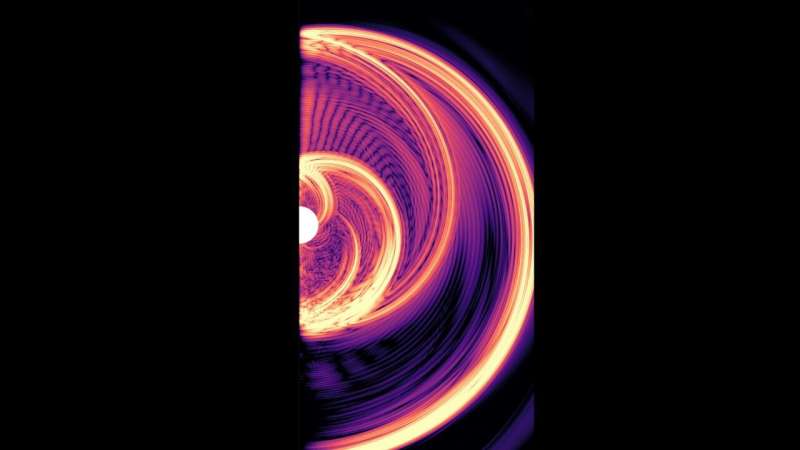August 14, 2024 feature
This article has been reviewed according to Science X's editorial process and policies. Editors have highlighted the following attributes while ensuring the content's credibility:
fact-checked
peer-reviewed publication
trusted source
proofread
Scientist performs the first nonlinear study of black hole mimickers

In recent research, a scientist from Princeton University has performed the first nonlinear study of the merger of a black hole mimicker, aiming to understand the nature of gravitational wave signals emitted by these objects, which could potentially help to identify black holes more accurately.
Black hole mimickers are hypothetical astronomical objects that mimic black holes, specifically in their gravitational wave signals and their effect on surrounding objects. However, they lack an event horizon, which is the point of no return.
The research was conducted by Nils Siemonsen, Associate Research Scholar at Princeton University, who spoke to Phys.org about his work.
"Black hole mimickers are objects remarkably close to black holes but lacking an event horizon. Observationally, we may be able to distinguish black holes from objects mimicking most of their properties using gravitational wave observations," he said.
The study, published in Physical Review Letters, focuses on a type of black hole mimicker called boson stars. The key to distinguishing them from black holes, according to Dr. Siemonsen, lies in the gravitational waves emitted when boson stars collide and merge.
Binary boson stars and mergers
Boson stars are one of the potential candidates for black hole mimickers, and as the name suggests, consist of bosons. Bosons are subatomic particles, like photons and the Higgs particle.
Boson stars consist of scalar bosons like the hypothetical axions, which are bosons with no spin, meaning they have no intrinsic angular momentum. The scalar fields of the particles form a gravitationally bound, stable configuration without needing strong interaction.
Previous research has shown that the merger of a binary boson star system leads to gravitational wave signals, which are ripples in spacetime caused by violent processes.
These signals are universally identical to that of a black hole ringdown (or the post-merger phase) independently of the black hole mimicker's internal structure.
The difference in the emitted gravitational wave signals is seen after a light-crossing time of the interior of the mimicker, which is the time taken by light to travel the diameter of the mimicker, which in this case is the boson star.
In the case of a black hole mimicker, this is characterized by repeated burst-like gravitational echoes.
In aiming to refine earlier research, Dr. Siemonsen sought to address issues like the lack of consideration for nonlinear gravitational effects and the exclusion of self-interactions among the matter of the object.
Nonlinear and self-consistent treatment of black hole mimickers
To address the limitations of the previous studies, Dr. Siemonsen used numerical simulations to solve the full Einstein-Klein-Gordon equations, which describe the evolution of scalar fields, such as those in boson stars.
For the merger, the study focused on large mass-ratio scenarios, i.e., the merger of a smaller boson star with a larger, more compact one, with the Klein-Gordon equations describing the head-on collision of the binary star system.
The Klein-Gordon equation, coupled with Einstein's field equations, which describe the gravitational dynamics, allows for the study of the self-consistent evolution of the system.
For solving the set of equations, Dr. Siemonsen used the Newton-Raphson relaxation technique with the fifth-order finite difference methods.
He explained the challenges with implementing these techniques: "Only under certain conditions does a black hole mimicker form from the merger of two boson stars. The region in the solution, where this occurs, is particularly challenging to simulate due to the large separation of scales."
To overcome these, methods like adaptive mesh refinement and very high resolution were used.
High frequency bursts
The simulations revealed that the gravitational wave signal of the ringdown contains a burst-like component with different properties, as previously believed, as well as a long-lived gravitational wave component.
"Neither of these components are present in a regular binary black hole merger and ringdown. This may guide future gravitational wave searches focusing on testing the black hole paradigm," explained Dr. Siemonsen.
However, the initial gravitational wave signal of a mimicker is similar to that of a rotating black hole, known as a Kerr black hole, as the primary (or larger) boson star becomes more compact and dense.
The study found that the timings of the bursts depend on the size of the smaller boson star involved in the merger.
Additionally, they found a long-lived component with a frequency comparable to what would be expected from a black hole, likely due to oscillations of the remnant object.
"Black holes settle down to their quiescent state over very short timescales. Black hole mimickers, on the other hand, are generically believed to re-emit some of the available energy at the merger in the form of gravitational waves during the latter's ringdown over relatively long timescales," explained Dr. Siemonsen.
Finally, the study revealed that the total energy emitted in the gravitational waves is significantly larger than expected from an equivalent black hole merger event.
Future work
The two components identified in the study could be used as a differentiator between a black hole merger remnant and a black hole mimicker.
"However, there are still many unanswered questions about properties of well-motivated black hole mimickers and their merger and ringdown dynamics," added Dr. Siemonsen.
Speaking of future work, he noted, "One interesting future direction is to consider a well-motivated black hole mimicker and understand its inspiral, merger, and ringdown dynamics in the context of a binary.
"Furthermore, analyzing the ringdown of these well-motivated mimickers using perturbative techniques and connecting these to nonlinear treatments is crucial to guide future tests of the black hole paradigm using gravitational wave observations."
More information: Nils Siemonsen, Nonlinear Treatment of a Black Hole Mimicker Ringdown, Physical Review Letters (2024). DOI: 10.1103/PhysRevLett.133.031401. On arXiv: DOI: 10.48550/arxiv.2404.14536
Journal information: Physical Review Letters , arXiv
© 2024 Science X Network





















